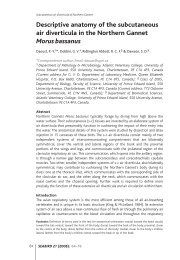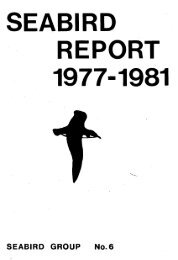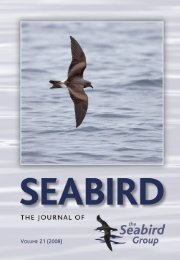Create successful ePaper yourself
Turn your PDF publications into a flip-book with our unique Google optimized e-Paper software.
2001 European Storm-petrel biology in Brittany 161<br />
unpubl. data), but an effect on laying date appears improbable. In alcids, the<br />
timing of laying appears quite constant from year to year within colonies.<br />
However, there are some occasional late years, apparently resulting from<br />
climatic conditions that may influence abundance and availability of food<br />
resources (Birkhead & Harris 1985; Harris & Wanless 1988). A potential link<br />
between food and late breeding was also suggested for the Black-legged<br />
Kittiwake (Coulson & Thomas 1985; Harris & Wanless 1997). A study of the<br />
Fork-tailed Storm-petrel Oceanodroma furcata in Alaska showed high betweenyear<br />
variability both in laying period, with a mean hatching date ranging over<br />
more than one month, and in chick growth (Boers ma & Parrish 1998). <strong>The</strong><br />
authors suggested that this was a direct response to environmental variability.<br />
Thus, year-to-year variability in the timing of laying recorded in the<br />
present study on European Storm-petrels, and the temporary break recorded in<br />
June 1998 (Fig. 1), may be attributable to variations in oceanographic conditions<br />
and food resources at sea just before laying, when females have to store<br />
energetic reserves for egg production. <strong>The</strong> event that led to a delay in laying in<br />
1998 should have been severe but confined to May-June only and not<br />
afterwards. It seems highly probable that other colonies, at least in the Celtic<br />
Sea, can exhibit similar year-to-year changes. Breeders originating from these<br />
different colonies may feed in adjacent areas of sea (Pollock et al. 1997) and<br />
encounter similar food conditions, and may thus respond in the same way to<br />
variation in food resources before egg laying.<br />
Several studies have reported the broad spectrum of prey eaten by<br />
European Storm-petrels, especially zooplankton (Scott 1970; Cramp &<br />
Simmons 1977, d’Elbée & Hémery 1998), but it may be possible that during the<br />
pelagic phase of the breeding cycle, females feed mainly on a few prey species<br />
(for example ichthyoplankton), and become more sensitive to changes in their<br />
availability or abundance.<br />
<strong>The</strong> El Niño Southern Oscillation (ENSO) climatic event has global<br />
and multifarious effects (Trenberth et al. 1998) and 1998 was the strongest ever<br />
recorded (Sydeman et al. 1999). It is tempting to propose a potential effect of El<br />
Niño on the laying period of European Storm-petrels. However, major ENSO<br />
events are generally associated in seabirds with effects over the whole breeding<br />
season and decreases in breeding numbers and breeding success (nest desertion,<br />
reduced productivity, etc.) or lower growth rate of chicks (Valle et al. 1987;<br />
Anderson et al. 1999; Sydeman et al. 1999). Clearly, no such effects were<br />
recorded in the present study (see Results; unpubl. data for chick growth). Other<br />
climatic events such as the <strong>No</strong>rth Atlantic Oscillation (NAO) or the Gulf Stream<br />
have direct effects on plankton communities (Fromentin & Planque 1996;<br />
Gerten & Adrian 2000), and, consequently, potentially on seabirds also (Hass<br />
1999). However, the relationships between climate and plankton appears








